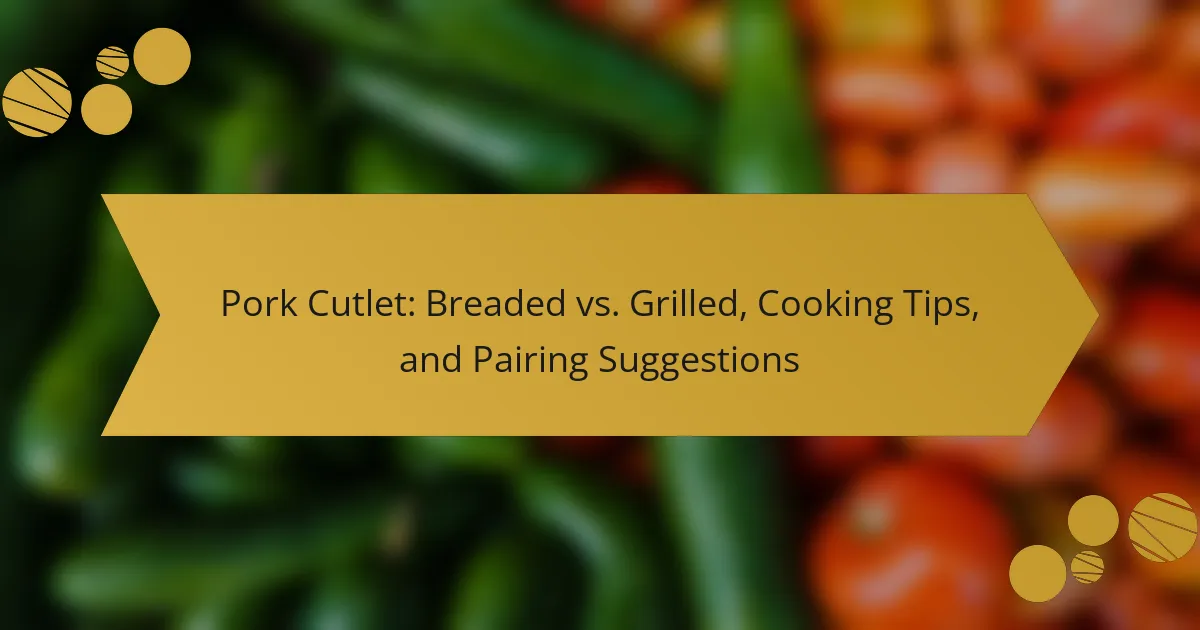
What is a Pork Cutlet?
A pork cutlet is a slice of pork, typically taken from the loin or tenderloin. It is usually boneless and can be prepared in various ways. Common cooking methods include grilling, frying, or baking. Pork cutlets are often breaded for added texture and flavor. They are a popular choice in many cuisines around the world. The cutlet is known for its tenderness when cooked properly. It can be served with various sides and sauces for enhanced taste. Pork cutlets are a good source of protein, making them a nutritious option.
How is a Pork Cutlet prepared?
A pork cutlet is prepared by first tenderizing the meat. This can be done using a meat mallet or rolling pin. Next, the cutlet is seasoned with salt and pepper. After seasoning, it is dipped in flour, then beaten eggs, and finally coated with breadcrumbs for a breaded cutlet. If grilling, the cutlet can be marinated instead of breaded. Cooking methods include frying in oil or grilling over medium heat. The cutlet is cooked until it reaches an internal temperature of 145°F. This ensures the meat is safe to eat and remains juicy.
What are the different cuts of pork used for cutlets?
The different cuts of pork used for cutlets include pork loin, pork tenderloin, and pork shoulder. Pork loin is often preferred for its tenderness and flavor. It is commonly sliced into cutlets for breading or grilling. Pork tenderloin is another popular choice due to its lean and tender nature. It is typically cut into medallions for quick cooking. Pork shoulder, while less common, can also be used for cutlets when properly trimmed. This cut offers a richer flavor but requires careful cooking to maintain tenderness. Each of these cuts provides unique textures and flavors suitable for various cooking methods.
What are the essential ingredients for a pork cutlet?
The essential ingredients for a pork cutlet are pork loin or pork chop, breadcrumbs, eggs, and seasoning. Pork loin or chop serves as the main protein source. Breadcrumbs provide a crispy coating when fried or baked. Eggs act as a binding agent to adhere the breadcrumbs to the meat. Seasoning, such as salt and pepper, enhances the flavor of the cutlet. These ingredients are commonly used in various recipes for pork cutlets.
What are the differences between Breaded and Grilled Pork Cutlets?
Breaded pork cutlets are coated in breadcrumbs before cooking, while grilled pork cutlets are cooked directly on a grill without any coating. The breading adds a crispy texture and additional flavor to the cutlets. In contrast, grilling enhances the natural flavor of the pork and allows for a charred exterior. Breaded cutlets typically require more oil for frying, whereas grilled cutlets are often healthier due to less added fat. Cooking methods also affect cooking time; breaded cutlets may take longer to cook through compared to grilled cutlets. Additionally, breaded cutlets are often served with sauces that complement the breading, while grilled cutlets can be paired with marinades or herbs to enhance their flavor.
How does the cooking method affect the flavor of pork cutlets?
The cooking method significantly affects the flavor of pork cutlets. Different methods create distinct taste profiles. For instance, breading and frying enhance richness and add a crispy texture. This method often infuses the cutlet with flavors from the breading. Grilling, on the other hand, imparts a smoky flavor and allows natural juices to concentrate. The Maillard reaction during grilling creates complex flavors. Additionally, cooking time and temperature influence tenderness and juiciness. Overcooking can lead to dryness, while proper cooking enhances flavor. Studies indicate that cooking methods alter the chemical composition of meat, affecting flavor perception.
What are the nutritional differences between breaded and grilled pork cutlets?
Breaded pork cutlets typically contain more calories and fat than grilled pork cutlets. A breaded cutlet can have around 250-300 calories per 100 grams, primarily due to the added breading and oil used in frying. Grilled pork cutlets, on the other hand, contain approximately 200-250 calories per 100 grams, as they are cooked without added fats.
Additionally, breaded cutlets often have higher carbohydrate content due to the breading, which can range from 20-30 grams per 100 grams. Grilled cutlets generally have negligible carbohydrates, focusing on protein content.
Protein levels are similar in both, averaging around 25 grams per 100 grams. However, breaded cutlets may have less protein density due to the additional breading.
In summary, grilled pork cutlets are lower in calories, fat, and carbohydrates compared to breaded variants, making them a healthier choice.
What are the cooking tips for perfecting Pork Cutlets?
To perfect pork cutlets, start by selecting the right cut of meat, such as boneless loin or tenderloin. Pound the cutlets to an even thickness for uniform cooking. Season the meat generously with salt and pepper to enhance flavor. For breaded cutlets, use a three-step breading process: flour, egg wash, and breadcrumbs. This creates a crispy exterior. Cook the cutlets in a hot skillet with oil for a golden crust. Use a meat thermometer to ensure an internal temperature of 145°F for safety. Let the cutlets rest before serving to retain juices. These tips will help achieve tender and flavorful pork cutlets.
How do you choose the right cooking method for pork cutlets?
Choose the right cooking method for pork cutlets based on desired texture and flavor. Breaded pork cutlets are typically pan-fried for a crispy exterior. This method retains moisture inside the meat while adding crunch. Grilling pork cutlets provides a smoky flavor and a charred texture. Grilling is ideal for lean cuts, as it allows fat to drip away. Consider the thickness of the cutlet when choosing a method. Thicker cutlets may benefit from baking after searing for even cooking. Cooking methods can also be influenced by personal preference and available equipment.
What are the best practices for seasoning pork cutlets?
The best practices for seasoning pork cutlets include using a balanced mix of salt, pepper, and herbs. Start by patting the cutlets dry to help the seasoning adhere better. Then, generously season both sides with salt and freshly ground black pepper. For added flavor, consider using garlic powder, onion powder, or smoked paprika. Fresh or dried herbs like thyme, rosemary, or parsley can enhance the taste. Allow the seasoned cutlets to rest for at least 15 minutes before cooking. This resting period helps the flavors penetrate the meat. Additionally, marinating the cutlets in a mixture of olive oil, vinegar, and spices for a few hours can provide deeper flavor. These practices ensure a well-seasoned and flavorful pork cutlet.
What are some popular pairing suggestions for Pork Cutlets?
Popular pairing suggestions for pork cutlets include applesauce, mashed potatoes, and sautéed vegetables. Applesauce complements the savory flavor of pork. Mashed potatoes provide a creamy texture that balances the dish. Sautéed vegetables add freshness and color to the plate. Other popular pairings are coleslaw, rice, and gravy. Coleslaw adds a crunchy contrast. Rice serves as a neutral base to absorb flavors. Gravy enhances the overall taste with richness. These pairings are commonly enjoyed with pork cutlets in various cuisines.
What side dishes complement pork cutlets well?
Mashed potatoes complement pork cutlets well. Their creamy texture balances the meat’s richness. Roasted vegetables enhance flavor and add color to the plate. A fresh salad provides a crisp contrast, refreshing the palate. Applesauce is a classic pairing, offering sweetness that complements the savory cutlets. Rice pilaf adds a light, fluffy side that absorbs juices. Coleslaw introduces a crunchy texture and tangy flavor. Each of these sides enhances the overall dining experience with pork cutlets.
How can sauces enhance the flavor of pork cutlets?
Sauces can significantly enhance the flavor of pork cutlets by adding moisture and depth. They introduce contrasting flavors that complement the meat. For example, a tangy barbecue sauce can balance the richness of fried cutlets. A creamy mustard sauce adds a zesty kick that elevates the dish. Marinades can infuse the pork with spices before cooking, enhancing overall taste. Additionally, reductions like balsamic glaze provide a sweet and savory profile. According to culinary experts, sauce pairings can transform simple dishes into gourmet experiences.
How can you troubleshoot common issues with Pork Cutlets?
To troubleshoot common issues with pork cutlets, first identify the problem. If the cutlets are tough, ensure they are not overcooked. Pork cutlets should be cooked to an internal temperature of 145°F. Use a meat thermometer for accuracy. If they are dry, consider marinating them before cooking. A marinade can help retain moisture. If the breading is falling off, ensure the cutlets are properly coated with egg wash before breading. This helps the breading adhere better. If the cutlets are bland, season them adequately with salt and pepper before cooking. Proper seasoning enhances flavor. For uneven cooking, ensure the cutlets are of uniform thickness. This allows for even heat distribution during cooking.
What should you do if your pork cutlet is too dry?
To remedy a dry pork cutlet, you can add moisture through various methods. Consider serving the cutlet with a sauce, such as gravy or a flavorful marinade. This will enhance the taste and provide moisture. Alternatively, you can slice the cutlet and incorporate it into a dish like a stir-fry or salad. This allows other ingredients to contribute moisture. Another option is to reheat the cutlet gently in a pan with a small amount of broth or water. This can help restore some juiciness. Cooking techniques, such as brining before cooking, can also prevent dryness in future preparations.
How can you avoid overcooking pork cutlets?
To avoid overcooking pork cutlets, monitor the internal temperature closely. Use a meat thermometer to check for doneness. The safe internal temperature for pork is 145°F (63°C). Remove the cutlets from heat when they reach this temperature. Let them rest for three minutes before serving. This allows the juices to redistribute. Cooking cutlets on medium heat helps prevent them from drying out. Additionally, consider using a marinade to enhance moisture retention. Proper timing and temperature control are essential for optimal results.
Pork cutlet, a boneless slice of pork typically sourced from the loin or tenderloin, is a versatile dish that can be prepared through various cooking methods such as breading and frying or grilling. This article covers essential preparation techniques, including the different cuts of pork suitable for cutlets, key ingredients, and cooking tips for achieving optimal flavor and tenderness. It also explores the nutritional differences between breaded and grilled options, popular side dishes and sauces that complement pork cutlets, and troubleshooting common cooking issues. Overall, the content provides a comprehensive guide to understanding and enhancing the culinary experience of pork cutlets.
